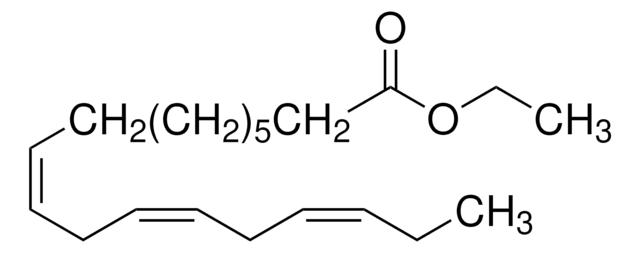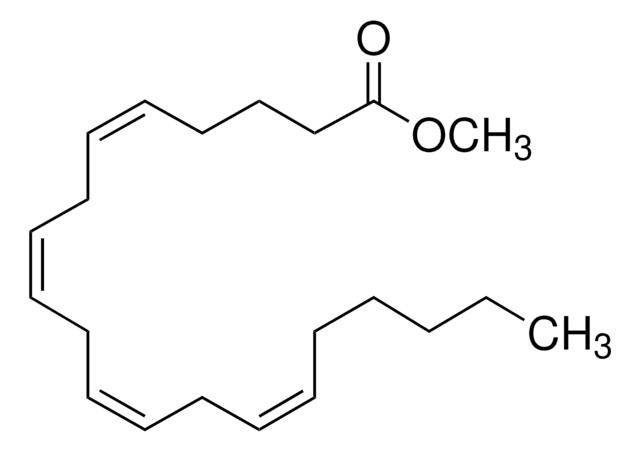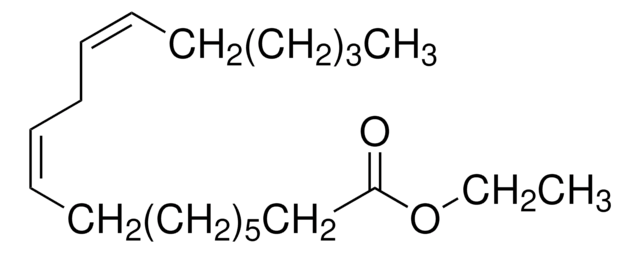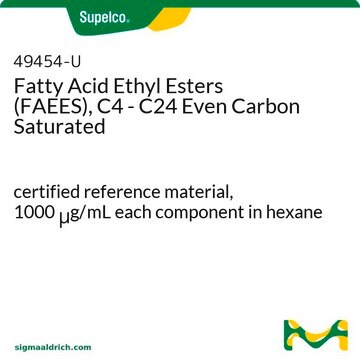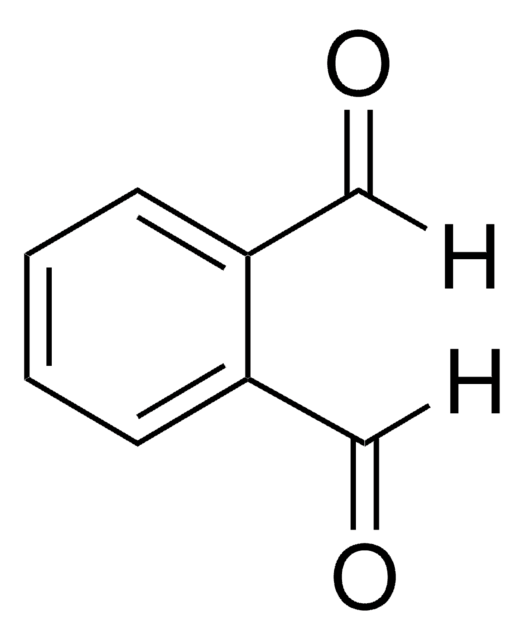すべての画像(2)
About This Item
実験式(ヒル表記法):
C22H36O2
CAS番号:
分子量:
332.52
MDL番号:
UNSPSCコード:
12352211
PubChem Substance ID:
NACRES:
NA.25
おすすめの製品
由来生物
fungus
品質水準
アッセイ
≥98.5% (GC)
フォーム
liquid
官能基
ester
脂質タイプ
omega FAs
輸送温度
ambient
保管温度
−20°C
SMILES記法
CCCCC\C=C/C\C=C/C\C=C/C\C=C/CCCC(=O)OCC
InChI
1S/C22H36O2/c1-3-5-6-7-8-9-10-11-12-13-14-15-16-17-18-19-20-21-22(23)24-4-2/h8-9,11-12,14-15,17-18H,3-7,10,13,16,19-21H2,1-2H3/b9-8-,12-11-,15-14-,18-17-
InChI Key
SNXPWYFWAZVIAU-GKFVBPDJSA-N
類似した製品をお探しですか? 訪問 製品比較ガイド
生物化学的/生理学的作用
アラキドン酸(AA)はオメガ6系の不飽和脂肪酸で、細胞膜リン脂質の構成成分です。ホスホリパ-ゼA2は、炎症応答により膜のリン脂質からAAを遊離します。AAはその後、少なくとも2つのシクロオキシゲナ-ゼ(COX)アイソフォ-ムによってプロスタグランジンおよびトロンボキサンに、リポキシゲナ-ゼによってロイコトリエンおよびリポキシンに、p450に触媒される代謝によりエポキシエイコサトリエン酸に、代謝されます。AAおよびその代謝産物は、シグナル伝達、収縮、走化性、細胞の増殖、分化およびアポト-シスなど、さまざまな生体内プロセスで重要な役割を演じます。AAはGタンパク質のαサブユニットに結合し、Ras GTPア-ゼ活性化タンパク質(GAP)の活性を阻害することが示されています。AAの細胞取り込みはエネルギ-依存性であり、形質膜の通過には輸送タンパク質による促進輸送が必要です。
包装
密封アンプル入り。
保管分類コード
10 - Combustible liquids
WGK
WGK 3
引火点(°F)
Not applicable
引火点(℃)
Not applicable
個人用保護具 (PPE)
Eyeshields, Gloves
適用法令
試験研究用途を考慮した関連法令を主に挙げております。化学物質以外については、一部の情報のみ提供しています。 製品を安全かつ合法的に使用することは、使用者の義務です。最新情報により修正される場合があります。WEBの反映には時間を要することがあるため、適宜SDSをご参照ください。
Jan Code
A9135-1G:
A9135-100MG:
A9135-25MG:
A9135-VAR:
A9135-10MG:
A9135-500MG:
A9135-BULK:
この製品を見ている人はこちらもチェック
D L Luthria et al.
Lipids, 28(9), 853-856 (1993-09-01)
Ethyl 5,8,11,14-eicosatetraenoate-19,19,20,20-d4 and ethyl 8,11,14-eicosatrienoate-19,19,20,20-d4 were synthesized by Grignard coupling of the methanesulfonyl ester of 2,5-undecadiyn-1-ol-10,10,11,11-d4 with 5,8-nonadiynoic acid and 8-nonynoic acid, respectively. The coupled products upon Lindlar reduction, followed by the preparation of their ethyl esters, yielded deuteriated ethyl
Majed A Refaai et al.
Clinical chemistry, 48(1), 77-83 (2001-12-26)
Fatty acid ethyl esters (FAEEs) are nonoxidative ethanol metabolites that have been implicated as mediators of alcohol-induced organ damage. FAEEs are detectable in the blood after ethanol ingestion, and on that basis have been proposed as markers of ethanol intake.
Kwang-Geun Lee et al.
Journal of agricultural and food chemistry, 51(24), 7203-7207 (2003-11-13)
The antioxidant activities of naturally occurring plant compounds were measured in a lipid peroxidation system consisting of ethyl arachidonate and Fenton's reagent. Inhibitory effects of 24 plant-derived flavonoids and 5 phenolic acids on malonaldehyde (MA) formation from ethyl arachidonate were
Yin Duan et al.
Comparative biochemistry and physiology. Toxicology & pharmacology : CBP, 148(3), 244-249 (2008-07-05)
Recent investigations in our laboratory showed that voltage-gated sodium channels (VGSCs) in brain are sensitive to inhibition by various synthetic cannabinoids and endocannabinoids. The present experiments examined the effects of the cannabinoid-1 (CB1) receptor agonist CP-55,940 and ethyl arachidonate on
Xinyu Zhang et al.
Analytica chimica acta, 963, 68-75 (2017-03-25)
The importance of ethanol non-oxidative metabolites as the specific biomarkers of alcohol consumption in clinical and forensic settings is increasingly acknowledged. Simultaneous determination of these metabolites can provide a wealth of information like drinking habit and history, but it was
ライフサイエンス、有機合成、材料科学、クロマトグラフィー、分析など、あらゆる分野の研究に経験のあるメンバーがおります。.
製品に関するお問い合わせはこちら(テクニカルサービス)